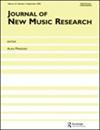八度-和弦进行的广义分析:全音阶/五度关系,缺失的基本音,完成音
IF 1.1
4区 计算机科学
Q4 COMPUTER SCIENCE, INTERDISCIPLINARY APPLICATIONS
引用次数: 1
摘要
在具有代表性的乐谱历史数据库中,在任何声音的每次开始都定义了一个响度。对8个三和弦——大调(047)、小调(037)、暂停音(027)、减弱音(036)、015、045、025、035——进行了前后音分析。令人惊讶的是,色度流行谱几乎不依赖于世纪或时间位置——特别是对于大/小三和弦(参见Krumhansl的关键谱)。根据简单模型的预测,每个三和弦的九个非和弦色度的轮廓受全音阶和第五关系的影响比缺少基本音(根音)或完成音(完成熟悉的四和弦的音)的影响更强烈。本文章由计算机程序翻译,如有差异,请以英文原文为准。
Octave-generalized analysis of chord progressions: Diatonic/fifth relations, missing fundamentals, completion tones
In a representative historical database of musical scores, a sonority was defined at every onset in any voice. For eight trichords—major (047), minor (037), suspended (027), diminished (036), 015, 045, 025, 035—immediately preceding and following sonorities were analysed. Chroma prevalence profiles depended surprisingly little on century or temporal position—especially for major/minor trichords (cf. Krumhansl’s key profiles). Profiles for nine non-chord chromas per trichord were influenced more strongly by diatonic scales and 5th relationships than missing fundamentals (roots) or completion tones (tones that complete familiar tetrachords) according to predictions of simple models.
求助全文
通过发布文献求助,成功后即可免费获取论文全文。
去求助
来源期刊

Journal of New Music Research
工程技术-计算机:跨学科应用
CiteScore
3.20
自引率
0.00%
发文量
5
审稿时长
>12 weeks
期刊介绍:
The Journal of New Music Research (JNMR) publishes material which increases our understanding of music and musical processes by systematic, scientific and technological means. Research published in the journal is innovative, empirically grounded and often, but not exclusively, uses quantitative methods. Articles are both musically relevant and scientifically rigorous, giving full technical details. No bounds are placed on the music or musical behaviours at issue: popular music, music of diverse cultures and the canon of western classical music are all within the Journal’s scope. Articles deal with theory, analysis, composition, performance, uses of music, instruments and other music technologies. The Journal was founded in 1972 with the original title Interface to reflect its interdisciplinary nature, drawing on musicology (including music theory), computer science, psychology, acoustics, philosophy, and other disciplines.
 求助内容:
求助内容: 应助结果提醒方式:
应助结果提醒方式:


